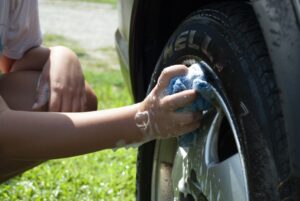When you own a car or any other vehicle, it requires special attention sometimes. One of those times is when you’re moving! It won’t matter much that you’ve spent a lot of time and money maintaining your vehicle if it gets damaged while you’re transporting it to your new home. Of course, with the right movers NJ, the odds of this are minimal. But it’s still vitally important that you prepare vehicles for shipping first. Preparation is always half the work when it comes to moving. So preparing your vehicle can make or break the relocation of it. It’s time, therefore, to learn how to do it right.
The first step to prepare vehicles for shipping is washing them
Whether you are preparing to ship your vehicles to a new address or just want to keep them in storage units NJ for a while, the first step to preparing them is always cleaning. This is because dust and dirt could potentially be hiding dents and scratches you may want to fix before shipping the vehicle off. But it’s also because cleaning the vehicle will save you time later on – even if you end up having to wash it again upon delivery, at least you’ll be dealing with a lot less grime. Finally, it’s always nice to have a clean car, isn’t it?

Always wash the car before shipping or storing it.
Don’t forget the interior when you prepare vehicles for shipping
It’s not just the outside of the vehicle that needs preparation before relocation or storage. You should also prepare the interior of the vehicle:
- clean the inside of the vehicle
- remove anything that is not secure (such as air fresheners or seat covers)
- remove the electronics that are not a part of the car
- turn off or remove automatic passes and toll tags
- turn off the alarm
These small changes can make the vehicle transportation safer and easier both for the vehicle itself and your movers.
Vehicle maintenance is an important step you mustn’t skip
When you need to prepare vehicles for shipping, especially if you’re moving long-distance, it is very important that you check they’re in good enough condition to be shipped in the first place. Relying on professional auto shippers will greatly reduce the risks to your vehicles. But it won’t completely remove them! Vehicles can easily get damaged during transportation. And vehicles that are already in poor condition have a higher chance of getting damaged badly. To avoid that, make sure that your vehicles are safe to move by performing some basic maintenance before shipping them.
Inspect the vehicle
The first thing you need to do is to inspect the vehicle. This is quite easy! Check for any dents or scratches on the outside and make sure the motor, breaks and dashboard are in working condition. If you’ve regularly performed maintenance on the vehicle before now, there shouldn’t be any issues! But if you’re worried about something or simply don’t know how to perform a thorough enough inspection yourself, consider asking for a professional vehicle inspection. Not only will this give you peace of mind, but it will also ensure you have a working vehicle once you’ve moved.
Check the fluids
Before you take your vehicle anywhere, you should check all the fluids in it – oil, fuel, transmission fluid, brake fluid, coolant and just about anything else you can think of. The canisters shouldn’t be completely empty, but they should also not be overly full. A quarter or a third is the advice you will usually hear from professionals. You should also check that there are no leaks. Moving companies may refuse to ship vehicles with serious leakage.

Charge the battery
If you want to drive your vehicle after its delivery, you’ll need to charge its battery. This is also useful in case your movers have to check that everything is in working order: with a full battery, they can easily just start the vehicle and perform routine checks before, during or after transportation.
Check the tire pressure
Tire damage is a common problem during transportation, especially in the loading and unloading phases. So make sure that your tires have enough pressure to withstand the trip. But don’t overinflate them either! This can have the opposite effect to what you want.
Empty the gas tank
Like all car fluids, gas should be emptied to a degree before shipping. You should only have 1/8 to 1/4 of a tank. Too little could cause damage to the tank, especially if you’re storing the vehicle for a while. Too much and the vehicle becomes heavy and dangerous to move.
Remove personal items when you prepare vehicles for shipping (but leave the tools)
If you’re moving, then personal items belong in all the other boxes your NJ packers are loading onto their trucks, not in your car. There are good chances they will come loose and damage something or make your vehicle heavier and therefore more costly to transport. So remove personal belongings from the vehicle and pack them elsewhere. The only things you should leave in the car are the toolbox and spare tires which can be used in case of emergency.

Take photographs for your records
Hoping for the best but preparing for the worst means you have to take into consideration the eventuality of something going wrong. So before you ship your vehicles, take photographs of them. That way you’ll have proof of the condition the vehicles were in before shipping in case something goes wrong during the transport.
Lock up after you prepare vehicles for shipping
Once you prepare vehicles for shipping, all that’s left is to lock up and get going! If you’re relying on professionals to ship your vehicles (which you definitely should be because auto shipping is a task that most are not up to), you probably won’t have much to worry about once these preparations are done. So relax and move on to other tasks now!


























